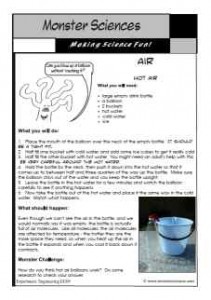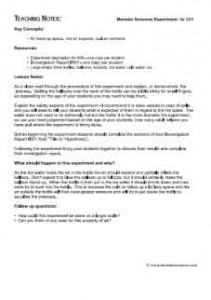Can you blow up a balloon without touching it or blowing into it? Find out how in this experiment about how temperature affects air.
 |
 |
An experiment about Air: Hot Air
What you will need:
• large empty drink bottle
• a balloon
• 2 buckets
• hot water
• cold water
• ice
What you will do:
1. Place the mouth of the balloon over the neck of the empty bottle. It should be a tight fit.
2. Half fill one bucket with cold water, and add some ice cubes to get it really cold
3. Half fill the other bucket with hot water. You might need an adult’s help with this. Be very careful around the hot water.
4. Hold the bottle by the neck, then push it down into the hot water so that it comes up to between half and three quarters of the way up the bottle. Make sure the balloon stays out of the water and you keep the bottle upright.
5. Leave the bottle in the hot water for a few minutes and watch the balloon carefully to see if anything happens.
6. Now take the bottle out of the hot water and place it the same way in the cold water. Watch what happens.
What is going on?
Even though we can’t see the air in the bottle, and we would normally say it was empty, the bottle is actually full of air molecules. Like all molecules, the air molecules are affected by temperature – the hotter they are the more space they need, so when you heat up the air in the bottle it expands and when you cool it back down it contracts.
Monster Challenges:
How do you think hot air balloons work? Do some research to check your answer.
TEACHING NOTES: Monster Sciences Experiment: Air A09
Topic:
Air: Air pressure
Key Concepts:
Air takes up space. Hot air expands, cool air contracts
Resources:
• Experiment description Air A09 – one copy per student.
• Investigation Report IR01 – one copy per student
• Large empty drink bottles, balloons, buckets, hot water, cold water, ice
Lesson Notes:
As a class read through the procedure of this experiment and explain, or demonstrate, the process. Getting the balloons over the neck of the bottle can be a little tricky for small fingers, so depending on the age of your students you may need to help them.
Explain the safety aspects of the experiment – I recommend it is done outside in case of spills and you will need to tell your students what is expected of them in regard to the hot water. The water does not need to be extremely hot but the hotter it is the more dramatic the experiment, so use your best judgement based on the age of your students, how many adult helpers you have and where the experiment is being done.
Before beginning the experiment students should complete the sections of their Investigation Report IR01 from ”Title to “Hypothesis”.
Following the experiment bring your students together to discuss their results and complete their investigation report.
What should happen in this experiment, and why?
As the hot water heats the air in the bottle the air should expand and partially inflate the balloon. Don’t expect it to blow the balloon up to full size, but it should certainly make the balloon stand up. When the bottle is then put in the ice water it should shrink down and may even try to suck into the bottle. This is because the cold air takes up a lot less space and the air outside the bottle will then have greater pressure and will try to get inside the bottle to equalise the pressure.
Follow up questions:
• How could this experiment be done on a larger scale?
• Can you think of any uses for this property of air?
Get this experiment here or as part of a bundle of Air Experiments here.
© www.monstersciences.com



